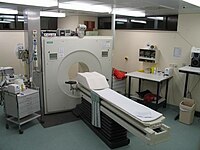
Photo from wikipedia
The intraoperative gamma probe (IPG) based on single gamma-ray detection remains the current gold standard modality for sentinel lymph node identification and tumor removal in cancer patients. However, IPGs do… Click to show full abstract
The intraoperative gamma probe (IPG) based on single gamma-ray detection remains the current gold standard modality for sentinel lymph node identification and tumor removal in cancer patients. However, IPGs do not meet the <5% false negative rate (FNR) requirement, a key metric suggested by the American Society of Clinical Oncology (ASCO). We aim to reduce FNR by using time of flight (TOF) PET detector technology in limited angle geometry system by using only two detector panels in coincidence. For proof of concept, we used two Hamamatsu TOF PET detector modules (C13500-4075YC-12) featuring 12× 12 arrays of 4.14× 4.14× 20 mm3 LFS crystal pixels with 4.2 mm pitch and coupled one-one to silicon photomultiplier (SiPM) pixels. The measured detector coincidence timing resolution (CTR) was 271 ps FWHM for the whole detector. We 3D printed lesion phantom containing spheres 2–10 mm in diameter, representing lymph nodes, and placed it inside a 10-liter warm background water phantom. Experimental results showed that with subminute data acquisition, 6 mm diameter spheres could be identified in the image when a lesion phantom with a 10:1 activity ratio to background was used. The simulation results were in good agreement with the experimental data by resolving 6 mm diameter spherical lesions with a 60 second acquisition time in a 25 cm deep background water phantom with a 10:1 activity ratio. As expected, the image quality improved as the CTR improved in the simulation and with decreasing background water phantom depth or increasing lesion-to-background activity ratio in the experiment. With the results presented here, we concluded that using a limited angle TOF PET detector system is a major step forward for intraoperative applications in that lesion detectability is beyond what conventional gamma- and NIR-based probes could achieve.
Journal Title: Journal of Instrumentation
Year Published: 2022
Link to full text (if available)
Share on Social Media: Sign Up to like & get
recommendations!